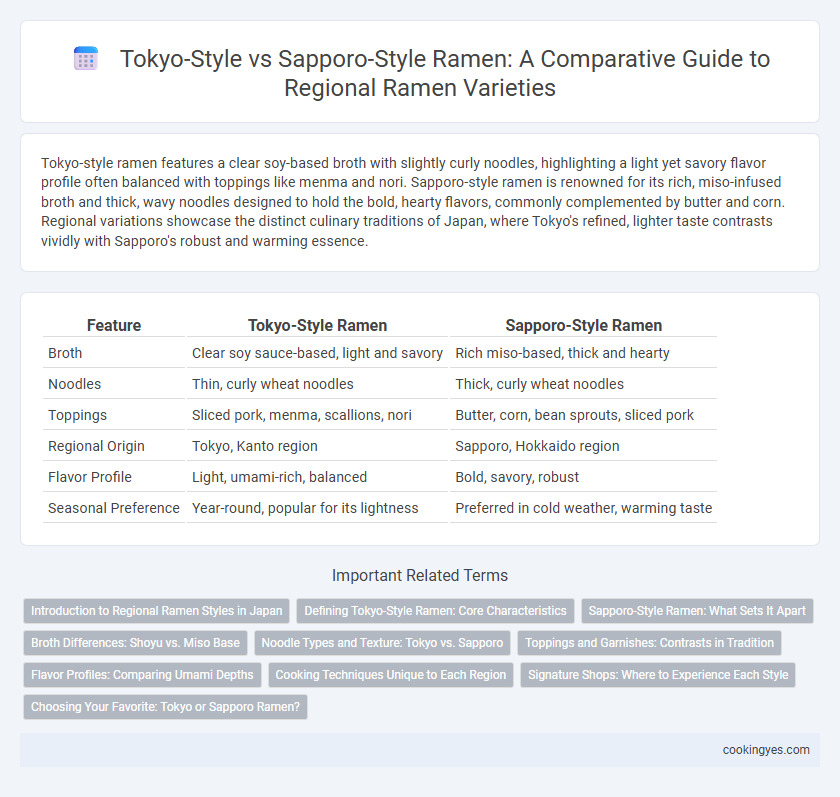Tokyo-style ramen features a clear soy-based broth with slightly curly noodles, highlighting a light yet savory flavor profile often balanced with toppings like menma and nori. Sapporo-style ramen is renowned for its rich, miso-infused broth and thick, wavy noodles designed to hold the bold, hearty flavors, commonly complemented by butter and corn. Regional variations showcase the distinct culinary traditions of Japan, where Tokyo's refined, lighter taste contrasts vividly with Sapporo's robust and warming essence.
Table of Comparison
| Feature | Tokyo-Style Ramen | Sapporo-Style Ramen |
|---|---|---|
| Broth | Clear soy sauce-based, light and savory | Rich miso-based, thick and hearty |
| Noodles | Thin, curly wheat noodles | Thick, curly wheat noodles |
| Toppings | Sliced pork, menma, scallions, nori | Butter, corn, bean sprouts, sliced pork |
| Regional Origin | Tokyo, Kanto region | Sapporo, Hokkaido region |
| Flavor Profile | Light, umami-rich, balanced | Bold, savory, robust |
| Seasonal Preference | Year-round, popular for its lightness | Preferred in cold weather, warming taste |
Introduction to Regional Ramen Styles in Japan
Tokyo-style ramen features a clear soy-based broth with medium-thin, curly noodles, reflecting the city's preference for lighter, balanced flavors. Sapporo-style ramen, originating from Hokkaido, is known for its rich, miso-based broth paired with thick, wavy noodles, often topped with sweet corn and butter to complement the cold climate. These regional variations highlight Japan's diverse culinary landscape and the influence of local ingredients and climate on ramen preparation.
Defining Tokyo-Style Ramen: Core Characteristics
Tokyo-style ramen features a clear, soy-based shoyu broth typically made from chicken and pork bones, combined with dried fish and vegetables for depth. The noodles are medium-thin, slightly curly, providing a springy texture that complements the savory broth. Toppings commonly include sliced pork (chashu), menma (bamboo shoots), green onions, and nori, reflecting the refined yet balanced flavor profile distinct to the Kanto region.
Sapporo-Style Ramen: What Sets It Apart
Sapporo-style ramen distinguishes itself with a rich, miso-based broth that intensifies the umami flavor, contrasting Tokyo-style's lighter soy sauce foundation. This Hokkaido specialty features robust toppings like sweet corn, butter, and ground pork, enhancing its hearty texture and unique taste profile. The use of thicker, curly noodles further complements Sapporo ramen's creamy and savory broth, creating a deeply satisfying regional dish.
Broth Differences: Shoyu vs. Miso Base
Tokyo-style ramen features a clear, soy sauce-based (shoyu) broth that is light yet savory, often complemented by chicken or vegetable stock for balanced umami. In contrast, Sapporo-style ramen is characterized by a rich, hearty miso-based broth, which provides a deep, slightly sweet flavor enhanced by pork or seafood stock. These broth distinctions reflect regional tastes, with Tokyo favoring subtle seasoning and Sapporo emphasizing robust, warming flavors suitable for colder climates.
Noodle Types and Texture: Tokyo vs. Sapporo
Tokyo-style ramen features thin, slightly curly noodles with a firm, springy texture that holds up well in soy-based shoyu broth, creating a balanced bite. In contrast, Sapporo-style ramen uses thick, wavy noodles with a chewy, dense texture specialized to absorb the rich, miso-infused soup typical of Hokkaido's cold climate. These distinct noodle choices reflect each region's adaptation to local tastes and environmental conditions, enhancing the overall ramen experience.
Toppings and Garnishes: Contrasts in Tradition
Tokyo-style ramen typically features soy sauce-based broth topped with sliced pork (chashu), bamboo shoots (menma), and green onions, emphasizing a lighter, clearer presentation. In contrast, Sapporo-style ramen is known for its rich, miso-based broth complemented by hearty toppings like corn, butter, bean sprouts, and ground pork, reflecting the region's colder climate and robust flavors. These distinctive garnishes highlight the unique culinary traditions that define each ramen style's regional identity.
Flavor Profiles: Comparing Umami Depths
Tokyo-style ramen features a clear soy-based broth with a balanced umami depth derived from chicken, pork, and dried fish, creating a light yet savory flavor profile that highlights subtle sweetness and saltiness. Sapporo-style ramen offers a rich, miso-based broth that delivers a deeper, more robust umami experience enhanced by hearty ingredients like butter, corn, and garlic, making it creamier and more intense. The contrast between Tokyo's delicate umami balance and Sapporo's bold, savory richness defines the regional flavor distinction critical to authentic ramen appreciation.
Cooking Techniques Unique to Each Region
Tokyo-style ramen features a clear, soy-based broth simmered with chicken and vegetables, emphasizing a light yet savory flavor achieved through precise skimming and slow simmering. Sapporo-style ramen is known for its rich, miso-based broth, often cooked with roasted pork bones and aromatic spices, utilizing a unique stir-frying technique of ingredients like garlic, ginger, and bean sprouts before adding the broth. The contrasting cooking methods reflect Tokyo's focus on clarity and subtlety, while Sapporo embraces boldness and depth through its hearty, layered preparation.
Signature Shops: Where to Experience Each Style
Tokyo-style ramen features a clear, soy-based broth with thin, curly noodles, best experienced at iconic shops like Ichiran and Rokurinsha, renowned for their refined flavors and rich umami. Sapporo-style ramen is characterized by its hearty miso broth, thick wavy noodles, and toppings like corn and butter, famously served at Ramen Shingen and Sumire, embodying Hokkaido's robust culinary tradition. Both regions highlight distinctive ingredients and preparation techniques, making their signature shops essential destinations for authentic ramen tasting.
Choosing Your Favorite: Tokyo or Sapporo Ramen?
Tokyo-style ramen features a clear soy-based broth with medium-thin, curly noodles that absorb the savory flavors, offering a lighter yet umami-rich experience. Sapporo-style ramen is distinguished by its rich miso-based broth combined with thick, wavy noodles and hearty toppings like corn and butter, creating a robust and warming dish ideal for cold climates. When choosing your favorite, consider whether you prefer the subtle complexity of Tokyo's soy broth or the bold, creamy depth of Sapporo's miso ramen.
Tokyo-style vs Sapporo-style for ramen regionality Infographic

 cookingyes.com
cookingyes.com